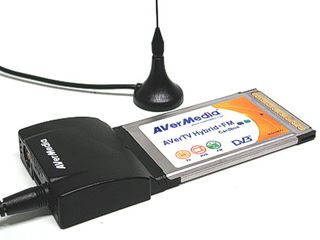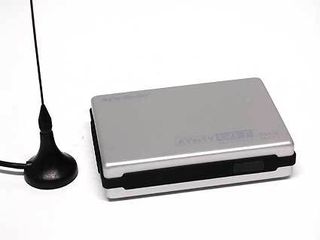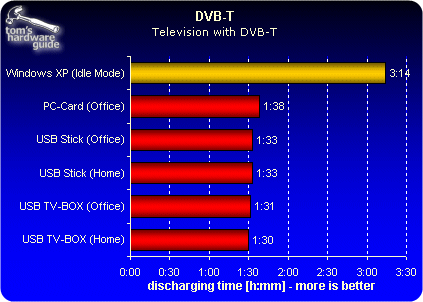Squeezing More Life Out of Your Notebook's Battery Part II
We were surprised by the many disparate sources of a notebook's battery drain. The complex interplay between software, components and peripherals during the tests we ran provided the basis for a checklist of what to do and what not to do to get the most out of any notebook's battery charge.
Mobile TV Cuts Battery Lifetime In Half

Avermedia: PC Card hybrid TV receiver.
Access to both analog and digital TV signals make a case for using a notebook as a portable TV. The necessary hardware to make this happen is available in different form factors and for different broadcast types from many commercial outlets.

DVB-T receiver in a handy USB stick format.
Our tests included three receivers of various types: an external TV USB box, a TV USB stick and a Hybrid TV PC card. Though our results are based on the European DVB-T digital TV standard, they shouldn't be too far off the mark for analog NTSC and OTA (over the air) All these technologies share the same basic capability - namely, turning your notebook into a TV receiver of sorts.

Avermedia's external USB TV receiver
Because signal strength received depends on the distance from the transmitter tower, and users experience different levels of signal quality in the real world, we decided to test all three devices and their respective battery lifetimes in two different locations, each with different sorts of TV signal conditions. We wanted to be able to use the different sets of measurements to draw conclusions about if and how much a weaker TV signal would impact battery lifetime. We conducted our first set of tests in the Munich THG offices, about five miles (7 km) from the transmitter tower (marked "Office" in the chart). To obtain a set of test results under optimal conditions, we repeated the same set of test in a home under half a mile (700 meters) away from the transmitter tower (marked "Home" in the chart).

In the house within view of the transmitter tower, signal strength shows nearly 100%.
Sign up to get the BEST of Tom's Guide direct to your inbox.
Get instant access to breaking news, the hottest reviews, great deals and helpful tips.
Discussion

The positive result from installation of a digital TV receiver is the fact that battery life doesn't markedly decrease even when the signal strength from the DVB-T transmitter is fairly weak. Likewise, by contrast with analog TV, digital picture quality is less dependent on signal strength and the quality is generally better. . Another consequence of digital reception is that the picture doesn't get increasingly worse as signal strength weakens, but rather shows increasing pixellation, blocking and simply disappears when signal quality falls below a tolerable threshold. It's either there or it's not.
Battery life is cut in half when you use your notebook as a mobile TV. That said, our measurements also confirm that this reduction is nearly the same for all three devices we tested, regardless of whether the signal is digital or analog mobileTV quickly loses its appeal. Our opinion is that using your laptop to watch TV while on the move is not a good idea. Who wants to tune into a movie or watch a sports event, only to have the battery go dead at a critical moment or when the home team is just about to score?
Current page: Mobile TV Cuts Battery Lifetime In Half
Prev Page Bad-quality Optical Media Shortens Battery Lifetime Next Page Use Of WLAN, LAN, And PAN Components